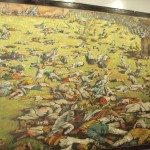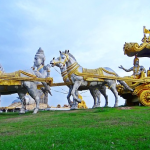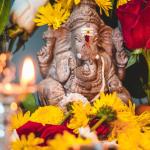Indians don’t eat beef much (mainly Christians and Muslims – along with some Hindus eat). Americans – specially in South – love their steaks and beefs. No connection?
There is.
In 1849, Dr. James Bolton Davis of Fairfield County, South Carolina – first imported cattle from India. The 3 main breeds were “Guzerat” (or, I assume Gujarat); Nellore, and Gir. He had come to know of the Indian – Bos indicus – the Indian species – cattle while serving as agricultural advisor to the Sultan of Turkey. Since then, there were repeated imports into the US of the Indian variety – specially in the Southern states of the US.
The US breed that emerged out of this entire cross-breeding was called Brahma or Brahman bulls.
Through centuries of exposure to inadequate food supplies, insect pests, parasites, diseases and the weather extremes of tropical India, the native cattle developed some remarkable adaptations for survival.
Two Indian bulls were given to Richard Barrow, a cotton and sugar planter of St. Francisville, LA., in 1854, by the British Crown in recognition of Mr. Barrow’s services of teaching cotton and sugar cane culture to a British representative who was to take these arts to India. The offspring of these cattle became known as “Barrow Grade” cattle, becoming widely known through the Gulf Coast region. The success of these two animals led to the importation of two more Indian bulls in 1885 by J.M. Frost and Albert Montgomery of Houston, Texas. By mating these two bulls to the offspring of the Barrow bulls, the first attempt to concentrate the blood of Bos indicus cattle in the United States was undertaken.
Basically the European breed was cross-bred with the Indian breed to come up with a stable breed that could withstand the temperature in the hot areas of the US in Southern states.
The Brahman has a distinct large hump over the top of the shoulder and neck, and a loose flap of skin (dewlap) hanging from the neck. Their ears are large and floppy. Bulls weigh 1600 to 2200 pounds (800 to 1,100 kg) and cows weigh 1000 to 1400 pounds (500 to 700 kg). At birth, calves weigh 60 to 65 pounds (30 to 33 kg). Despite their huge size, they are known as a docile intelligent breed, if handled with kindness from calfhood.
What are some of the advantages of the Brahma breed?
Brahmans have a greater ability to withstand heat than European cattle. They have more sweat glands, and also an oily skin, thought to help repel pest insects along with a smooth coat. They are also more resistant to parasites and disease.
So, when you see a poor looking cow walking down the street in India – you might wonder how one of her long lost cousin may be in the US, being fed the best food possible to make it fatter.. so it could end up in a slaughter house!
We, in India, of couse, don’t kill our cows.. we just merely starve them to death!















